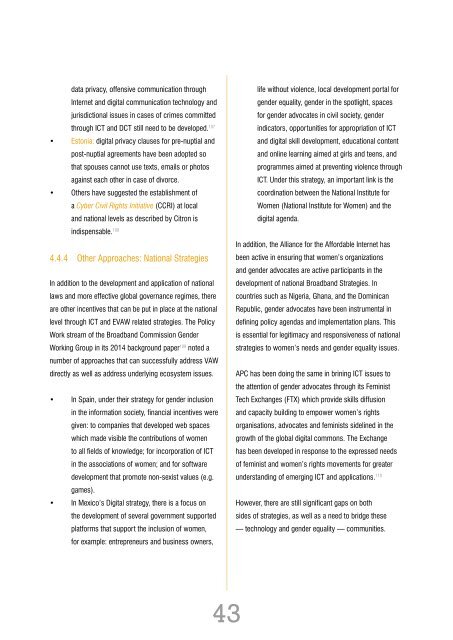CYBER VIOLENCE AGAINST WOMEN AND GIRLS
cyber_violence_gender%20report
cyber_violence_gender%20report
You also want an ePaper? Increase the reach of your titles
YUMPU automatically turns print PDFs into web optimized ePapers that Google loves.
data privacy, offensive communication through<br />
Internet and digital communication technology and<br />
jurisdictional issues in cases of crimes committed<br />
through ICT and DCT still need to be developed. 107<br />
• Estonia: digital privacy clauses for pre-nuptial and<br />
post-nuptial agreements have been adopted so<br />
that spouses cannot use texts, emails or photos<br />
against each other in case of divorce.<br />
• Others have suggested the establishment of<br />
a Cyber Civil Rights Initiative (CCRI) at local<br />
and national levels as described by Citron is<br />
indispensable. 108<br />
4.4.4 Other Approaches: National Strategies<br />
In addition to the development and application of national<br />
laws and more effective global governance regimes, there<br />
are other incentives that can be put in place at the national<br />
level through ICT and EVAW related strategies. The Policy<br />
Work stream of the Broadband Commission Gender<br />
Working Group in its 2014 background paper 109 noted a<br />
number of approaches that can successfully address VAW<br />
directly as well as address underlying ecosystem issues.<br />
• In Spain, under their strategy for gender inclusion<br />
in the information society, financial incentives were<br />
given: to companies that developed web spaces<br />
which made visible the contributions of women<br />
to all fields of knowledge; for incorporation of ICT<br />
in the associations of women; and for software<br />
development that promote non-sexist values (e.g.<br />
games).<br />
• In Mexico’s Digital strategy, there is a focus on<br />
the development of several government supported<br />
platforms that support the inclusion of women,<br />
for example: entrepreneurs and business owners,<br />
life without violence, local development portal for<br />
gender equality, gender in the spotlight, spaces<br />
for gender advocates in civil society, gender<br />
indicators, opportunities for appropriation of ICT<br />
and digital skill development, educational content<br />
and online learning aimed at girls and teens, and<br />
programmes aimed at preventing violence through<br />
ICT. Under this strategy, an important link is the<br />
coordination between the National Institute for<br />
Women (National Institute for Women) and the<br />
digital agenda.<br />
In addition, the Alliance for the Affordable Internet has<br />
been active in ensuring that women’s organizations<br />
and gender advocates are active participants in the<br />
development of national Broadband Strategies. In<br />
countries such as Nigeria, Ghana, and the Dominican<br />
Republic, gender advocates have been instrumental in<br />
defining policy agendas and implementation plans. This<br />
is essential for legitimacy and responsiveness of national<br />
strategies to women’s needs and gender equality issues.<br />
APC has been doing the same in brining ICT issues to<br />
the attention of gender advocates through its Feminist<br />
Tech Exchanges (FTX) which provide skills diffusion<br />
and capacity building to empower women’s rights<br />
organisations, advocates and feminists sidelined in the<br />
growth of the global digital commons. The Exchange<br />
has been developed in response to the expressed needs<br />
of feminist and women’s rights movements for greater<br />
understanding of emerging ICT and applications. 110<br />
However, there are still significant gaps on both<br />
sides of strategies, as well as a need to bridge these<br />
— technology and gender equality — communities.<br />
43


